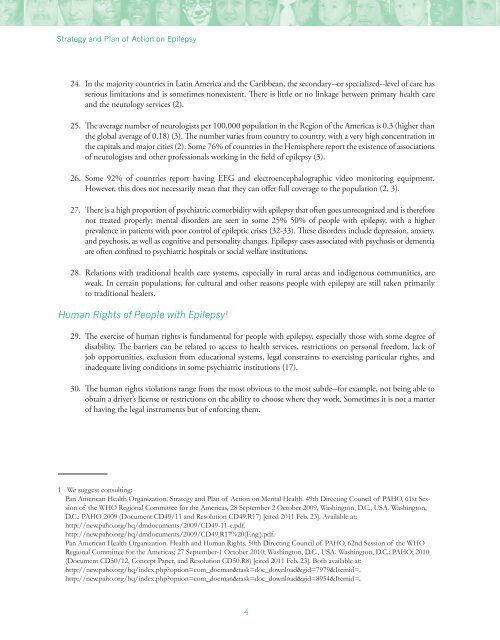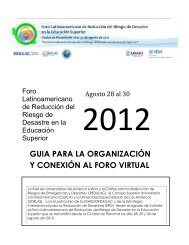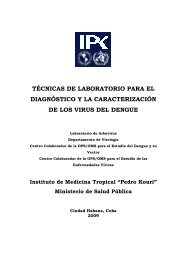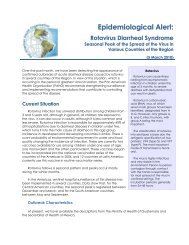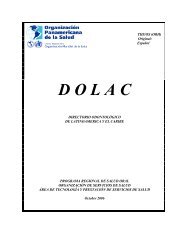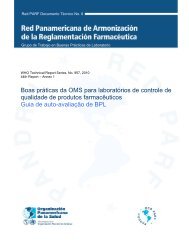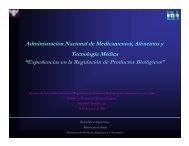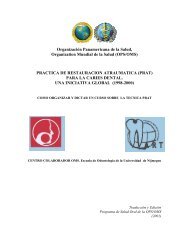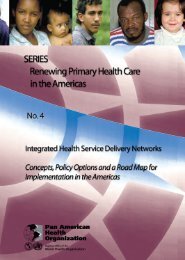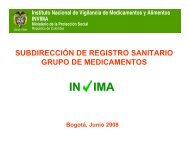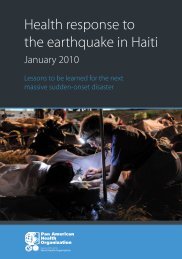Strategy and Plan of Action on Epilepsy - PAHO/WHO
Strategy and Plan of Action on Epilepsy - PAHO/WHO
Strategy and Plan of Action on Epilepsy - PAHO/WHO
You also want an ePaper? Increase the reach of your titles
YUMPU automatically turns print PDFs into web optimized ePapers that Google loves.
<str<strong>on</strong>g>Strategy</str<strong>on</strong>g> <str<strong>on</strong>g>and</str<strong>on</strong>g> <str<strong>on</strong>g>Plan</str<strong>on</strong>g> <str<strong>on</strong>g>of</str<strong>on</strong>g> <str<strong>on</strong>g>Acti<strong>on</strong></str<strong>on</strong>g> <strong>on</strong> <strong>Epilepsy</strong><br />
24. In the majority countries in Latin America <str<strong>on</strong>g>and</str<strong>on</strong>g> the Caribbean, the sec<strong>on</strong>dary--or specialized--level <str<strong>on</strong>g>of</str<strong>on</strong>g> care has<br />
serious limitati<strong>on</strong>s <str<strong>on</strong>g>and</str<strong>on</strong>g> is sometimes n<strong>on</strong>existent. There is little or no linkage between primary health care<br />
<str<strong>on</strong>g>and</str<strong>on</strong>g> the neurology services (2).<br />
25. The average number <str<strong>on</strong>g>of</str<strong>on</strong>g> neurologists per 100,000 populati<strong>on</strong> in the Regi<strong>on</strong> <str<strong>on</strong>g>of</str<strong>on</strong>g> the Americas is 0.3 (higher than<br />
the global average <str<strong>on</strong>g>of</str<strong>on</strong>g> 0.18) (3). The number varies from country to country, with a very high c<strong>on</strong>centrati<strong>on</strong> in<br />
the capitals <str<strong>on</strong>g>and</str<strong>on</strong>g> major cities (2). Some 76% <str<strong>on</strong>g>of</str<strong>on</strong>g> countries in the Hemisphere report the existence <str<strong>on</strong>g>of</str<strong>on</strong>g> associati<strong>on</strong>s<br />
<str<strong>on</strong>g>of</str<strong>on</strong>g> neurologists <str<strong>on</strong>g>and</str<strong>on</strong>g> other pr<str<strong>on</strong>g>of</str<strong>on</strong>g>essi<strong>on</strong>als working in the field <str<strong>on</strong>g>of</str<strong>on</strong>g> epilepsy (3).<br />
26. Some 92% <str<strong>on</strong>g>of</str<strong>on</strong>g> countries report having EEG <str<strong>on</strong>g>and</str<strong>on</strong>g> electroencephalographic video m<strong>on</strong>itoring equipment.<br />
However, this does not necessarily mean that they can <str<strong>on</strong>g>of</str<strong>on</strong>g>fer full coverage to the populati<strong>on</strong> (2, 3).<br />
27. There is a high proporti<strong>on</strong> <str<strong>on</strong>g>of</str<strong>on</strong>g> psychiatric comorbidity with epilepsy that <str<strong>on</strong>g>of</str<strong>on</strong>g>ten goes unrecognized <str<strong>on</strong>g>and</str<strong>on</strong>g> is therefore<br />
not treated properly; mental disorders are seen in some 25% 50% <str<strong>on</strong>g>of</str<strong>on</strong>g> people with epilepsy, with a higher<br />
prevalence in patients with poor c<strong>on</strong>trol <str<strong>on</strong>g>of</str<strong>on</strong>g> epileptic crises (32-33). These disorders include depressi<strong>on</strong>, anxiety,<br />
<str<strong>on</strong>g>and</str<strong>on</strong>g> psychosis, as well as cognitive <str<strong>on</strong>g>and</str<strong>on</strong>g> pers<strong>on</strong>ality changes. <strong>Epilepsy</strong> cases associated with psychosis or dementia<br />
are <str<strong>on</strong>g>of</str<strong>on</strong>g>ten c<strong>on</strong>fined to psychiatric hospitals or social welfare instituti<strong>on</strong>s.<br />
28. Relati<strong>on</strong>s with traditi<strong>on</strong>al health care systems, especially in rural areas <str<strong>on</strong>g>and</str<strong>on</strong>g> indigenous communities, are<br />
weak. In certain populati<strong>on</strong>s, for cultural <str<strong>on</strong>g>and</str<strong>on</strong>g> other reas<strong>on</strong>s people with epilepsy are still taken primarily<br />
to traditi<strong>on</strong>al healers.<br />
Human Rights <str<strong>on</strong>g>of</str<strong>on</strong>g> People with <strong>Epilepsy</strong> 1<br />
29. The exercise <str<strong>on</strong>g>of</str<strong>on</strong>g> human rights is fundamental for people with epilepsy, especially those with some degree <str<strong>on</strong>g>of</str<strong>on</strong>g><br />
disability. The barriers can be related to access to health services, restricti<strong>on</strong>s <strong>on</strong> pers<strong>on</strong>al freedom, lack <str<strong>on</strong>g>of</str<strong>on</strong>g><br />
job opportunities, exclusi<strong>on</strong> from educati<strong>on</strong>al systems, legal c<strong>on</strong>straints to exercising particular rights, <str<strong>on</strong>g>and</str<strong>on</strong>g><br />
inadequate living c<strong>on</strong>diti<strong>on</strong>s in some psychiatric instituti<strong>on</strong>s (17).<br />
30. The human rights violati<strong>on</strong>s range from the most obvious to the most subtle--for example, not being able to<br />
obtain a driver’s license or restricti<strong>on</strong>s <strong>on</strong> the ability to choose where they work. Sometimes it is not a matter<br />
<str<strong>on</strong>g>of</str<strong>on</strong>g> having the legal instruments but <str<strong>on</strong>g>of</str<strong>on</strong>g> enforcing them.<br />
1 We suggest c<strong>on</strong>sulting:<br />
Pan American Health Organizati<strong>on</strong>. <str<strong>on</strong>g>Strategy</str<strong>on</strong>g> <str<strong>on</strong>g>and</str<strong>on</strong>g> <str<strong>on</strong>g>Plan</str<strong>on</strong>g> <str<strong>on</strong>g>of</str<strong>on</strong>g> <str<strong>on</strong>g>Acti<strong>on</strong></str<strong>on</strong>g> <strong>on</strong> Mental Health. 49th Directing Council <str<strong>on</strong>g>of</str<strong>on</strong>g> <strong>PAHO</strong>, 61st Sessi<strong>on</strong><br />
<str<strong>on</strong>g>of</str<strong>on</strong>g> the <strong>WHO</strong> Regi<strong>on</strong>al Committee for the Americas, 28 September 2 October 2009, Washingt<strong>on</strong>, D.C., USA. Washingt<strong>on</strong>,<br />
D.C.: <strong>PAHO</strong> 2009 (Document CD49/11 <str<strong>on</strong>g>and</str<strong>on</strong>g> Resoluti<strong>on</strong> CD49.R17) [cited 2011 Feb. 23]. Available at:<br />
http://new.paho.org/hq/dmdocuments/2009/CD49-11-e.pdf.<br />
http://new.paho.org/hq/dmdocuments/2009/CD49.R17%20(Eng.).pdf.<br />
Pan American Health Organizati<strong>on</strong>. Health <str<strong>on</strong>g>and</str<strong>on</strong>g> Human Rights. 50th Directing Council <str<strong>on</strong>g>of</str<strong>on</strong>g> <strong>PAHO</strong>, 62nd Sessi<strong>on</strong> <str<strong>on</strong>g>of</str<strong>on</strong>g> the <strong>WHO</strong><br />
Regi<strong>on</strong>al Committee for the Americas; 27 September-1 October 2010; Washingt<strong>on</strong>, D.C., USA. Washingt<strong>on</strong>, D.C.: <strong>PAHO</strong>; 2010<br />
(Document CD50/12, C<strong>on</strong>cept Paper, <str<strong>on</strong>g>and</str<strong>on</strong>g> Resoluti<strong>on</strong> CD50.R8) [cited 2011 Feb. 23]. Both available at:<br />
http://new.paho.org/hq/index.php?opti<strong>on</strong>=com_docman&task=doc_download&gid=7979&Itemid=.<br />
http://new.paho.org/hq/index.php?opti<strong>on</strong>=com_docman&task=doc_download&gid=8954&Itemid=.<br />
4


